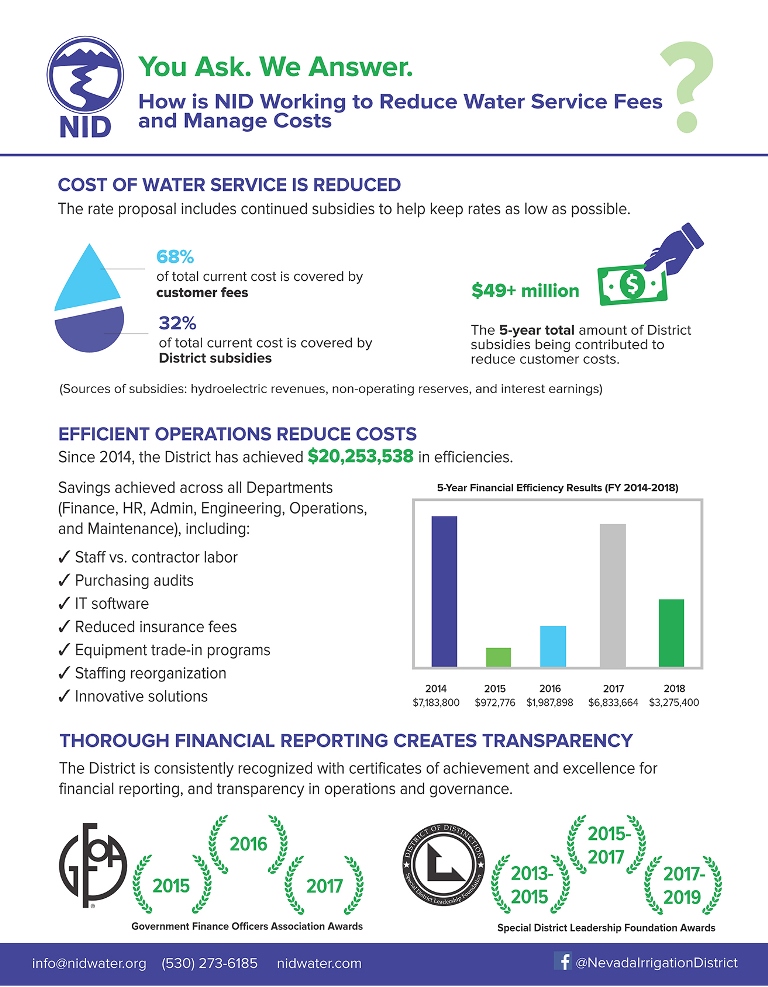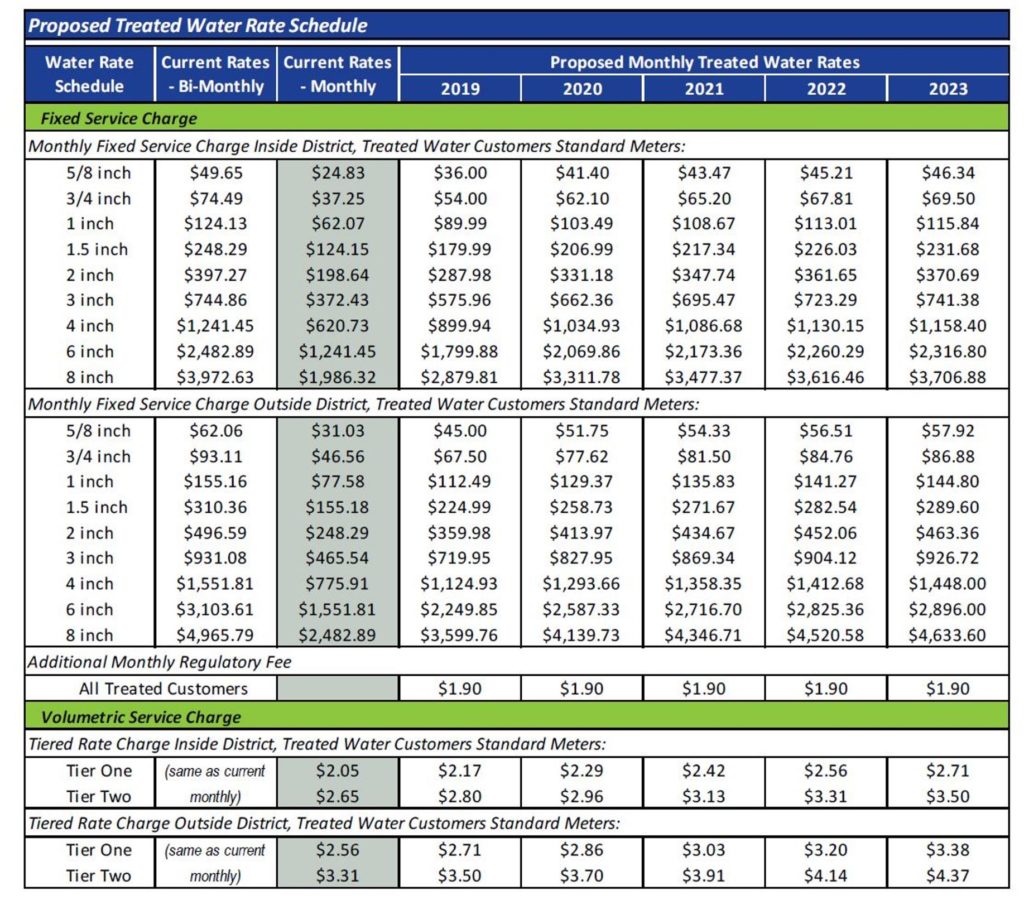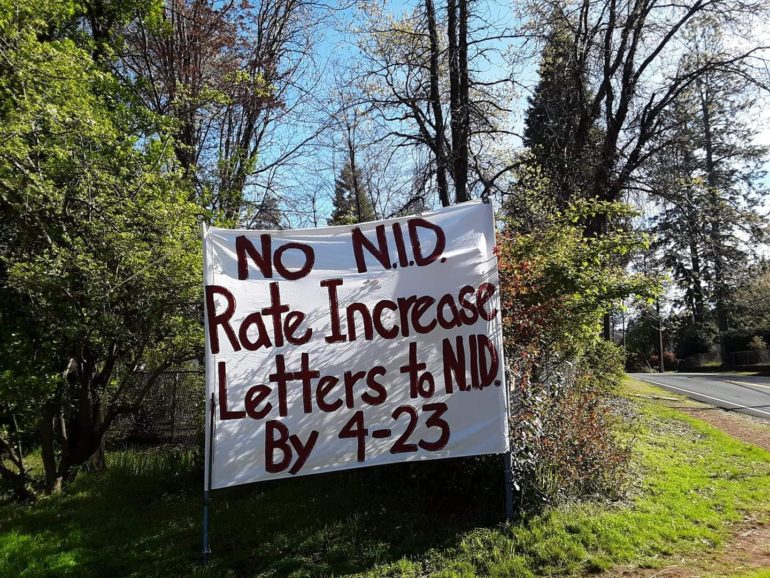Peaceful Shirley
2019
Increases in
Water Rates
Every five years, the District reviews and evaluates its operations, system requirements and requirements to ensure customer charges reflect current costs. The proposed rate increase is necessary for NID to recover its costs to provide services, maintain its infrastructure, encourage water use efficiency and maintain its long-term fiscal stability.
Public safety and the health of our water system are the highest priorities for NID. The District operates on a promise to provide our customers throughout the foothills of Placer, Nevada and Yuba Counties with a dependable and high-quality supply of drinking and irrigation water.
Please read on to learn more about the water rates proposal. There is also an FAQs page (click here) that provides even more detailed information.
You Ask. We Answer.
Through our water rates community information meetings and outreach, we’ve heard a few common questions and concerns. We also know that the proposed water rates information is complex and takes time to understand. To help address these questions and support understanding of the District’s budgeting and operations, we are creating infographics and fact sheets that can be easily viewed, downloaded or shared. See below for content in our You Ask. We Answer. information series!

How were the proposed increased rates determined?
Water rate increases are being proposed based on the findings of the District’s Water Rate Cost of Service Study and recommendations from the District’s Water Rates Committee (WRC).
The Water Rate Cost of Service Study is a comprehensive analysis of the District’s water rates that addresses a number of key factors such as fairness and equity in rates, revenue sufficiency, and adequate funding of reserves.
The Water Rates Committee was a community-based stakeholder group, comprised of 10 members of NID’s customer base (five treated water customers and five raw water customers, as well as two NID Directors). Together, they met throughout 2018 and identified revenue requirements for the District in an effort to meet adequate revenue requirements and to secure healthy financial reserves.
Some of the key findings and recommendations include:
The District’s new financial plan uses transfers from Hydroelectric Division revenues faqs-banner-copy($34 million) and non-operating ($6.9 million) to reduce water rates paid by customers.
Water rates account for about 68 percent of the $40.8 million projected cost of water service in 2019. This 68 percent gradually increases to 77 percent of the actual costs over a five-year period.
Throughout the prior five years, the District experienced about $8 million in loss of revenue due to drought. Because of this, the WRC adjusted the base rate in order to collect 50 percent of fixed costs, thereby improving revenue stability and the overall financial health of the District going forward.
As an additional measure related to the drought, the District is implementing a drought/ conservation rate schedule intended to offset revenue losses during periods of mandated, emergency conservation measures.
The District should implement new water rates for small hydroelectric generators to cover the District’ costs of providing benefits to these customers.
The Water Fund’s five-year financial plan projects an operating cash reserve of four months, thus short of the Board’s six-month policy. However, given reasonable assumptions as discussed in the report, the 10-Year financial plan reaches a six-month operating reserve level while also funding other reserves.
> Read the Cost of Service Study here.
Proposed changes include new standard, drought, and hydroelectric rate schedules
Both treated (residential) and raw (irrigation) water customers would see changes to their standard water rates. For a small number of raw water customers, an additional hydroelectric rate adjustment is applicable. Customers will also be subject to a drought rate schedule if the District’s Drought Contingency Plan needs to be enacted.
Standard Treated Water Rates
The proposed treated water rate change means that a typical residential customer would see their fixed service charge increase an average of $13.07 more per month in 2019. The fixed service charge increases proportionally with the meter size. In addition, the typical volumetric service charge (commodity) increase would be $0.27 for each unit of water used monthly.

Standard Raw Water Rates
For the typical raw water customer, the proposed rate change would increase their fixed service charge an average of $27.64 more and the variable service charge increase would be $16.29 more per Miners Inch (MI) for the 2019 irrigation season.
Hydroelectric Rates
There are a small number of individuals served by the District who divert water for the purpose of generating power. Providing raw water to these individuals for this purpose results in increased operating costs for the District to monitor, patrol, track, and report on these activities. Under the new rate schedule, these individuals would pay the base rate and 10% of the volumetric service charge for raw water customers.
Drought Rates
Helping customers conserve water and save on their water bill is a value of the District. Conservation efforts on behalf of both customers and the District are also a crucial way to stretch our limited supply and be responsive to the effects of climate change and future drought. However, reduced consumption also means reduced water sales and decreases to the District’s projected rate revenue. Consideration of this reality is thus a necessary part of factoring base rates, particularly in light of the District’s proposed rate structure that only collects 50% of the fixed costs through fixed charges, leaving the balance collected through volumetric service charges.
When the District is subjected to mandated conservation measures or for other reasons declares drought stages as defined in the District Drought Contingency Plan, the District incurs additional costs. These costs include additional conservation programs such as education, public outreach, and monitoring, as well as purchasing of additional water supplies for customer use. The proposed drought rate schedules vary between treated and raw water customers; amounts are dependent on the Stage (severity of drought) declared.
There’s more, there’s more, there’s more!!! But we’re moving on to the protest part!
Protesting the Proposed Rate Change
Customers can file a written protest to the proposed rates. Only one protest perprop218 parcel is permitted and must be filed by an owner or tenant, and not both.
For protests to be counted, the written protest must be mailed or delivered to the Nevada Irrigation District, Attn: Customer Service, 1036 West Main Street, Grass Valley, CA 95945 at or before the conclusion of the public hearing on April 24, 2019.
If the District receives written protests representing a majority of the affected parcels, the proposed rate increase will not be implemented.
All written protests must contain:
A description of the property (such as address and/or parcel number) sufficient to identify the property
A signature of the property owner or tenant
If the protest is submitted by someone whose name is not listed on the water bill or on the last equalized county assessment roll for property ownership, written evidence should be provided that the protest is submitted by a tenant of property owner.
What if you’re a future property owner???






